Here is the slide show we viewed on Monday (with a few minor changes) showing images of the work of Hokusai as well as Mary Cassatt, Toulouse Lautrec and Degas.
Saturday, January 29, 2011
Wednesday, January 26, 2011
Hokusai and Mary Cassatt

On Monday we looked at work from the Japanese artist Hokusai. We also discussed "Japonisme", i.e.: the influence that Hokusai and other Japanese artists had on the Impressionists in France in the mid 1800s, focusing on Mart Cassatt.
Check here for more information on Hokusai's work.
Look here for the complete works of Mary Cassatt!
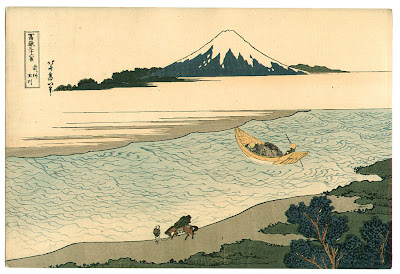
Monday, January 24, 2011
Ukiyo-e "The Fleeting Pleasures of Life"
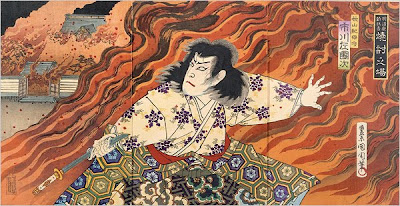
Here is a link to more information about the fascinating history of Ukiyo-e, "Images of the Floating World" or "The Fleeting Pleasures of Life".
Fleeting Pleasure of Life
Wednesday, January 19, 2011
Tantra Art Slide Show
Please view the Tantra Art Slide Show below. File size made it necessary to uploaded it in two parts.
ENJOY!
ENJOY!
Tuesday, January 18, 2011
Zentangle Zendoodle Art Play- Hand in Circle Mandala by Milliande
Zentangle, Zendoodle...who knew this existed! Now your doodling can have an official name. I find the forms enchanting. I hope you enjoy the video and that this brings your doodling to new heights.
A reminder about the homework:
1) Practice creating many contour line drawings of rooms, outdoor scenes, faces. As you are drawing look for the circles, squares, and triangles to be found within your drawings. '
2) Doodle, doodle, doodle. You may want to try a Zendoodle
3)And always...draw what you love!
Tantra Art Exhibit in New York City
Here is a brief description of Tantra Art and a link to Feature, Inc. an amazing gallery in New York City.
Sunday, January 16, 2011
Doodling for Clarity

Pam Turner pointed out this great interview on NPR's Talk of the Nation with Lynda Barry who wrote Picture This: The Near-Sighted Monkey Book.
Lynda talks about the relationship between the doodling and creativity, thinking, processing information and emotional well-being.
Doodling brings us moments of clarity and insight, made possible by the physical action involved in moving a pencil across a piece of paper.
If you have time please click on the link below and open Listen to the Story.
...you won't regret it!
Lynda Barry interview
Saturday, January 15, 2011
Right Brain - Left Brain Shift

In her wonderful book Drawing on the Right Side of the Brain Betty Edwards discusses in detail how to purposefully switch from the linear, language bound part of your brain (sometimes called left brain) to the non-linear, spatial part of your brain, (sometimes called right brain).
Specifically it means turning off that part of your brain that quickly assesses and names the things in your world; that looks, comprehends and then dismisses what you see. Learning to draw means, instead, to see the objects in your world in terms of line direction, shape, value, and spatial relationships. These things do not have to be named; merely observed, attended to, and transcribed onto paper.
Blind contour drawings are one way to facilitate this switch.
Yet another way is to take another drawing, turn it upside down and redraw it. This helps us see the spatial relationships rather than the objects we are drawing.

Wednesday, January 12, 2011
In a Perfect World

On Monday (not so eloquently) I attempted to float a few ideas about Plato's notions of idealized form. These ideas have left us with a parallel world we carry around and unconsciously measure ourselves against.
Here is a link to more information about the philosophic basis for how we think about our world...
Platonic Realism
However, for the purposes of drawing (and perhaps many other things in life) such ideas get in our way. How fun might it be to consider that all the things that are less than perfect in our world are what make it interesting and fun to be here.
Try courting those imperfections and "mistakes" in your drawing...see where they might take you.
And enjoy this Big Think segment from Malcolm Gladwell about the messy, chaotic nature of a creative life...
Embrace Chaos - Malcolm Gladwell on Big Think
Tuesday, January 11, 2011
Something Fun to Explore
We know that Degas did not try to draw everything. He rarely included buildings and architectural elements in his work. He never drew landscapes unless it involved a race track. However, he loved dancers, horses, portraits, the human figure...and he drew these subjects obsessively.
This week spend a little time thinking about those things that obsess you...that you love to look at.... Try looking through old photos or images from postcards that you've saved if that helps.
When you pinpoint those things that you can't take your eyes from, that turn you into the proverbial moth around a candle flame, then you will have found what you need to draw.
The next step, of course, is to draw those things as often as you can. Make photos and work from those if that seems fun for you. Your work as an artist begins with finding the lyrical, the beautiful or the just plain fascinating....what obsesses you....and using it in your work.
This week spend a little time thinking about those things that obsess you...that you love to look at.... Try looking through old photos or images from postcards that you've saved if that helps.
When you pinpoint those things that you can't take your eyes from, that turn you into the proverbial moth around a candle flame, then you will have found what you need to draw.
The next step, of course, is to draw those things as often as you can. Make photos and work from those if that seems fun for you. Your work as an artist begins with finding the lyrical, the beautiful or the just plain fascinating....what obsesses you....and using it in your work.
Blind Contour vs. Contour Drawings
In our first session we experimented with blind contour and contour drawing. A bit more information may be helpful. Contour drawing refers to using line to contain the outside edge of an object or form. Our last drawing was made as a pure contour line drawing. Contour line drawings are most often made with the eye moving back and forth between the subject and the paper in order to check line direction, shape, proportion, etc. Pure contour drawings contain no shading or tonal values. Here are some examples of contour drawings by Matisse, Grosz and Picasso.
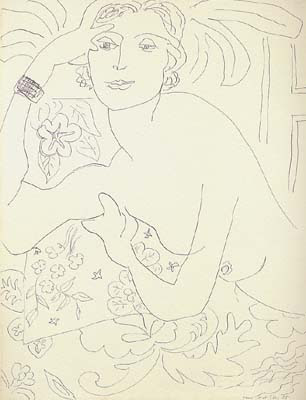
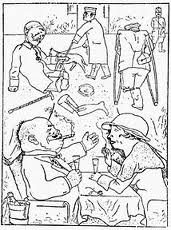

Blind contour drawing is a sort of artist's "calisthenics". It is often used as an exercise to quiet the mind and focus the eye; to coordinate the eye and hand, and focus one's perception in order to foster a type of pure seeing. Blind contour drawings are done by looking only at the subject. The eye does not check in with the drawing surface. The drawing as a "product" takes a backseat to the act of focused seeing. The pencil stays in contact with the paper at all times and "touches" the subject as one draws. It is best to work quite slowly. Aim to have the pencil and the eye at the same point as one works on the drawing. Here are some examples of blind contour drawings.
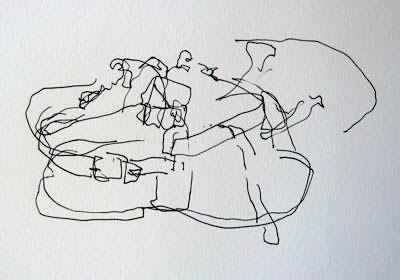
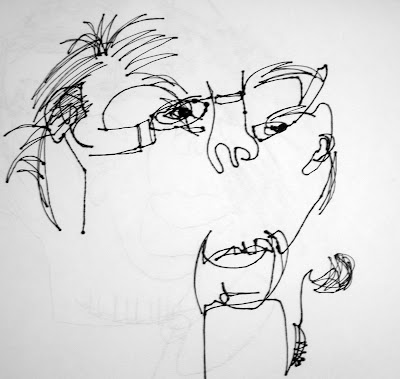
Check out this link for more information on blind contour drawing...
More Blind Contour Practice



Blind contour drawing is a sort of artist's "calisthenics". It is often used as an exercise to quiet the mind and focus the eye; to coordinate the eye and hand, and focus one's perception in order to foster a type of pure seeing. Blind contour drawings are done by looking only at the subject. The eye does not check in with the drawing surface. The drawing as a "product" takes a backseat to the act of focused seeing. The pencil stays in contact with the paper at all times and "touches" the subject as one draws. It is best to work quite slowly. Aim to have the pencil and the eye at the same point as one works on the drawing. Here are some examples of blind contour drawings.


Check out this link for more information on blind contour drawing...
More Blind Contour Practice
Sunday, January 9, 2011
Edgar Degas

Here are a couple of links about the French artist, Edgar Degas. We will be looking at Degas' work more in class. Enjoy this preview!
In addition check out the "Urban Sketchers" blog on the right! This is a great blog for people who travel with their sketchbook in hand...
Edgar Degas on Rusart
Edgar Degas on Buzzle
Thursday, January 6, 2011
Greetings - Let's Draw!
Welcome to "East Meets West - Drawing in the Space Between". This blog will be your resource for information from class sessions. I will also be posting links, images, and information that looks interesting or helpful in our quest to become better observers of our world.
During our class sessions we will be observing and drawing the external objective reality of our daily lives and we will be contemplating our inner world, what is important to us and what moves us, what interests us and what motivates us to create.
Here's looking forward to the adventure!
During our class sessions we will be observing and drawing the external objective reality of our daily lives and we will be contemplating our inner world, what is important to us and what moves us, what interests us and what motivates us to create.
Here's looking forward to the adventure!
Subscribe to:
Comments (Atom)